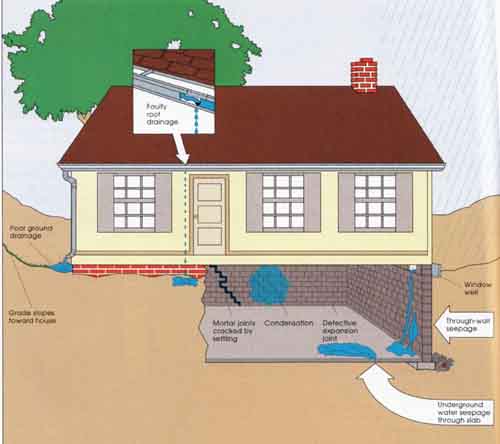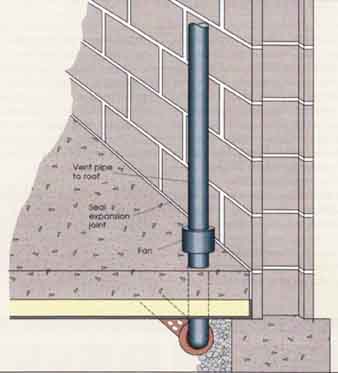Most problems unique to basements are caused by water. The first step in drying out a wet basement is to determine where the water is coming from. Is condensation the culprit? Is water seeping in from outside, or trickling through a crack in a wall or the floor? Is a high water table trying to push your basement out of the ground? As you investigate each of these possibilities, as described below, bear in mind that the problem could be the result of a combination of ills.

WHERE’S THE WATER COMING FROM? If your basement has
a moisture problem, these are the key points to check. Grade slopes toward
house? Underground water seepage through slab? Through-wall seepage?
After identifying the source or sources of the problem, see below for
solutions.
CONDENSATION
The prime symptoms of condensation are damp walls and pipes—especially in humid weather—rusty hardware, mold or mildew, and a musty odor. To find out for sure, tape a piece of foil to the dampest wall and check it a day or two later. If the outer face has fogged up or is beaded with droplets of water, your basement is suffering from a condensation problem.
Condensation results from excess humidity, often from an internal source such as a washing machine, unvented dryer, or basement shower. It forms where warm moist air comes in contact with a significantly cooler surface such as an exterior wall or a cold water pipe.
Cure condensation by installing a de humidifier, improving basement ventilation, or wrapping cold-water pipes, and insulation. Then apply a damp-proofing compound to the walls, as shown below.
SEEPAGE
If moisture is collecting on the floor or on one wall near the floor, it’s probably seeping in from outside or up from under the floor. Tape a piece of foil to the wall and wait for a rainy day. If water collects behind the foil, you have a seep age problem.
Seepage usually occurs because water is forcing through an expansion joint or through pores and hairline cracks in the foundation. First look around outside and see if you can identify a source for the water. Perhaps a gutter is leaking or overflowing, or a downspout (leader) lacks a splash block or ground pipe. Maybe a window well is filling up and flooding. Also check that the ground around your house is graded away from the foundation, not to ward it. Repairing gutters and leaders is explained in Section 22; for information about solving foundation drainage problems, see Section 25.
Sealing basement walls, as shown below, may stop minor seepage. If not, install a channeling system or hire a waterproofing contractor to employ one of the strategies illustrated below.
LEAKS
Often you can see water trickling down a basement wall or oozing up through a crack in the floor. As you look for the source of a leak, pay special attention to mortar joints between blocks or the expansion joint between the wall and the basement floor.
Most basement leaks result from poor drainage, especially roof runoff, or a grading problem, aggravated by cracks that result from the normal settling of the structure. Check for these as explained above. Most leaks can be plugged with hydraulic cement (see below); walls that are extensively cracked need professional attention.
UNDERGROUND WATER
One of the most troublesome causes of a chronically damp basement is a spring or high water table that pushes water up through the floor under high pressure. This often shows up as a thin, almost imperceptible film. To deter mine if you have an underground water problem, lay a sheet of plastic on the floor and leave it there for two or three days. If moisture collects under the sheet, it's coming up from below. An underground water problem requires professional help.
PROTECTING AGAINST RADON Odorless, colorless, and radioactive radon gas comes from the natural decay of radium into Soil and underground water. Emitted through cracks and joints in basement floors and walls, it can build up in concentrations that, over the years, can pose a serious health hazard. Home centers sell radon testing kits, with instructions telling how to use them and an address to which you can send samples for laboratory analysis. If the analysis indicates that your home has a radon problem, the same measures that keep water out of basements can also provide a barrier against radon. If these don’t work, a waterproofing or pollution- control specialist can install a venting system that pulls radon from underneath the floor and discharges it into the air. This is not a feasible do-it- yourself job.
|
